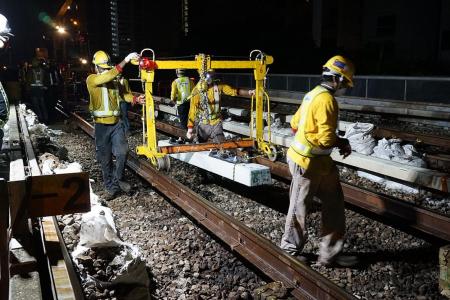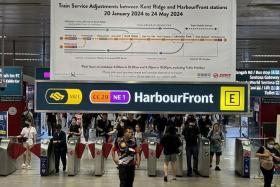Faster rides on East-West line from February
Speed limit on East-West MRT line to return to 80kmh next month
Commuters using the island's oldest MRT lines can expect improvements in the coming months, with faster journeys on the East-West Line (EWL), along with the roll-out of a new signalling system for the North-South Line (NSL).
Next month, speed limits imposed on the EWL due to a sleeper replacement project will be lifted, allowing trains to return to normal speeds of up to 80kmh, instead of being capped between 40kmh and 60kmh.
Sleepers help to hold the tracks in place, and worn ones can lead to a rough ride.
From March onwards, a new signalling system will be progressively rolled out on the NSL.
While the new system has the capability to run trains at 100-second intervals during peak hours, instead of 120 currently, the Land Transport Authority (LTA) did not say when the faster arrivals will be implemented.
Running trains at shorter intervals helps to boost capacity and ease congestion.
On Taipei's metro, for example, trains can arrive as frequently as 90 seconds apart.
Updates on these works were revealed yesterday, as the LTA and operator SMRT commemorated the completion of the North-South and East-West Lines' (NSEWL) three-year sleeper replacement project.
A ceremony was held at Jurong East MRT station, with Transport Minister Khaw Boon Wan signing a plaque to be placed at Clementi MRT station, where the last upgraded sleeper was installed on the westbound tracks.
A total of 188,000 timber sleepers on the 29-year-old NSEWL were replaced with hardier, concrete ones between August 2013 and last month.
Throughout the project, speed limits were imposed on sections where sleepers were newly laid, to give them time to settle on the ballast, on which tracks are laid.
INCREASING RELIABILITY
Mr Lee Ling Wee, managing director of SMRT Trains, said that replacing sleepers increases the reliability and safety of train services.
"If the track foundation is not stable, it will result in higher vibrations and damage to equipment, on the tracks as well as on the trains."
Yesterday, the LTA also gave an update on the NSL's signalling system upgrade.
From March, it will start implementing the new communications-based train control system during off-peak periods, when ridership is lower, before extending it to the peak periods.
LTA's deputy chief executive for infrastructure and development Chua Chong Kheng said: "As we learnt from other operators elsewhere which have embarked on similar projects, during the initial stages of such launches, there will inevitably be some teething issues."
Compared to the current fixed-block system, the new system relays the exact location and speed of every train to a computer, so they can travel closer together.
For the EWL, more than 85 per cent of the signalling upgrading works have been done and the LTA expects it to be operational next year.
Mr Julian Lim, a 30-year-old nurse who travels on the NSL almost daily, is looking forward to faster train arrivals.
He said: "Now, it's very packed during the peak hours, and I can't get a seat."
Get The New Paper on your phone with the free TNP app. Download from the Apple App Store or Google Play Store now



